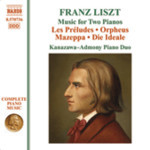
Liszt: Complete Piano Music Vol 29: Music for two pianos (Incls 'Les Preludes')
 $25.00
Out of Stock
$25.00
Out of Stock6+ weeks add to cart
FRANZ LISZT
Liszt: Complete Piano Music Vol 29: Music for two pianos (Incls 'Les Preludes')
Franz Liszt Piano Duo
[ Naxos / CD ]
Release Date: Friday 1 August 2008
This item is currently out of stock. It may take 6 or more weeks to obtain from when you place your order as this is a specialist product.
Liszt's symphonic poems were the cause of some contemporary controversy. One of the most influential critics in Vienna, Eduard Hanslick, a champion of Brahms, wrote in 1857 of the impertinence of such an attempt to produce music 'capable of fiddling and blowing the most magnificent phenomena of myth and history, the most profound thoughts of the human mind'. Hanslick's objection was not to music with some extra-musical association, but to the vastness of the subjects tackled and what he saw as a reliance on an external programme to justify an absence of musical content.
Born at Raiding, in Hungary, in 1811, the son of Adam Liszt, a steward in the service of Haydn's former patrons, the Esterházy Princes, Franz Liszt had early encouragement from members of the Hungarian nobility, allowing him in 1822 to move to Vienna, for lessons with Czerny and a famous meeting with Beethoven, who was said, in spite of his profound deafness, to have applauded the boy's performance and kissed him, the so-called Weihekuss, that seemed to proclaim him as Beethoven's heir. From Vienna Liszt moved to Paris, where Cherubini refused him admission to the Conservatoire. Nevertheless he was able to impress audiences by his performance, now supported by the Erard family, piano manufacturers whose wares he was able to advertise in the concert tours on which he embarked. In 1827 Adam Liszt died, and Franz Liszt was now joined again by his mother in Paris, while using his time to teach, to read and benefit from the intellectual society with which he came into contact. His interest in virtuoso performance was renewed when he heard the great violinist Paganini, whose technical accomplishments he now set out to emulate.
The years that followed brought a series of compositions, including transcriptions of songs and operatic fantasies, part of the stock-in-trade of a virtuoso. Liszt's relationship with a married woman, the Comtesse Marie d'Agoult, led to his departure from Paris for years of travel abroad, first to Switzerland, then back to Paris, before leaving for Italy, Vienna and Hungary. By 1844 his relationship with his mistress, the mother of his three children, was at an end, but his concert activities continued until 1847, the year in which his association began with Carolyne zu Sayn-Wittgenstein, a Polish heiress, the estranged wife of a Russian prince. The following year he settled with her in Weimar, the city of Goethe, turning his attention now to the development of a newer form of orchestral music, the symphonic poem, and, as always, to the revision and publication of earlier compositions.
It was in 1861, at the age of fifty, that Liszt moved to Rome, following Princess Carolyne, who had settled there a year earlier. Divorce and annulment seemed to have opened the way to their marriage, but they now continued to live in separate apartments in the city. Liszt eventually took minor orders and developed a pattern of life that divided his time between Weimar, where he imparted advice to a younger generation, Rome, where he was able to pursue his religious interests, and Pest, where he returned now as a national hero. He died in 1886 in Bayreuth, where his daughter Cosima, widow of Richard Wagner, lived, concerned with the continued propagation of her husband's music.
Liszt's symphonic poems were the cause of some contemporary controversy. One of the most influential critics in Vienna, Eduard Hanslick, a champion of Brahms, wrote in 1857 of the impertinence of such an attempt to produce music 'capable of fiddling and blowing the most magnificent phenomena of myth and history, the most profound thoughts of the human mind'. Hanslick's objection was not to music with some extra-musical association, but to the vastness of the subjects tackled and what he saw as a reliance on an external programme to justify an absence of musical content.
Tracks:
Les Preludes, S637/R359
Orpheus, S638/R360
Mazeppa, S640/R362
Die Ideale, S646/R368